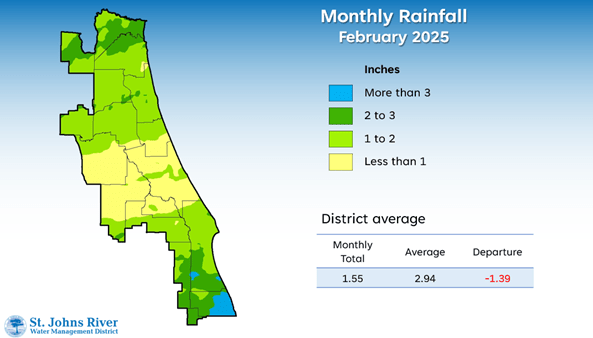February rainfall drops as District enters driest months

A map illustrates rainfall conditions in February across the St. Johns River Water Management District.

A map illustrates rainfall conditions in February across the St. Johns River Water Management District.
February rainfall across the District was below average for the month, with 16 counties receiving less than their typical monthly totals. Meanwhile, eight counties remained above their 12-month rainfall average, while Osceola, Brevard, Indian River, and Alachua counties were at least four inches below their annual norms. Despite these regional variations, aquifer levels remain healthy.
With limited rainfall expected in the coming months, as Florida enters its driest season, residents are encouraged to use water efficiently, such as following water restrictions and using smart irrigation practices.
A full report outlining February’s hydrologic conditions was presented at the District’s Governing Board meeting. Highlights include:
Rainfall
- Districtwide rainfall averaged 1.55 inches, which is 1.39 inches below the monthly norm.
- Rainfall totals varied across the region, ranging from 3.19 inches in Indian River County to just 0.81 inches in Volusia County.
- Okeechobee and Indian River counties recorded above normal rainfall, with a small area in Indian River County receiving up to 6 inches in February.
- Annual rainfall across the District reached 52.48 inches, exceeding the long-term average by 1.47 inches.
- Northern counties continue to receive the most rainfall throughout the year, with Nassau County exceeding 60 inches of total annual precipitation.
- 10 counties have recorded above normal annual rainfall, with Nassau, Duval and Volusia counties more than 6 inches above their averages.
Groundwater
- Upper Floridan Aquifer levels continue to be healthy overall for this time of year, with water levels in the normal to high range across the District.
- Districtwide groundwater levels, expressed as a single index, were in the 65th percentile, which is in the normal range for this time of year.
- High groundwater levels support and recharge the aquifer as we approach our driest months, but they don’t lessen the importance of encouraging continued water conservation practices.
Spring flows
- Silver Springs recorded a mean monthly flow of 729 cubic feet per second (cfs), or 471 million gallons per day (mgd), a 22 cfs decrease from last month but still within the high range for this time of year.
- In Volusia County, the Blue Spring station reported record levels as provisional data show a mean monthly flow of 191 cfs (123 mgd).
- Mean monthly flow at Rock Springs was 67 cfs (43 mgd), near the top of the high range.
- Wekiwa Springs recorded a mean monthly flow of 72 cfs (47 mgd). These data indicate that through the month flow was at a record level for this time of year.
For further insights into rainfall totals and other hydrologic data, visit www.sjrwmd.com.
Visit WaterLessFlorida.com for tips to help landscapes thrive while saving water and money. Follow the water conservation conversation at #sjrwmd #waterconservation #savewater.

